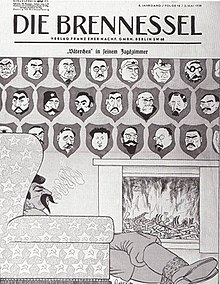Die Brennessel
 May 1938 cover alluding to the Great Purge by Stalin | |
| Editor | Wilhelm Weiss |
|---|---|
| Categories | Satirical magazine |
| Frequency | Weekly |
| Publisher | Franz Eher Nachfolger |
| First issue | January 1931 |
| Final issue | 1938 |
| Country | Germany |
| Based in | Munich |
| Language | German |
Die Brennessel (German: The Stinging Nettle) was a weekly satirical magazine which was published in Munich, Germany, between 1931 and 1938. It was one of the publications which were established to gain popularity among Germans in favor of the Nazi Party.[1] The magazine employed humor as a tool for Nazi propaganda.[2]
History and profile
Die Brennessel was first published in January 1931.[3] The start of the magazine was announced in the official magazine of the Nazi Party, Illustrierter Beobachter, stating "We set our new weekly journal Die Brennessel against this poison of Jewish incitement and of making things contemptuous. It will be an excellent propaganda weapon for our supporters."[2] The publisher of Die Brennessel was the Munich-based Franz Eher Nachfolger, which was affiliated with the Nazi Party.[1][2] The company published many propaganda brochures, books and periodicals of the party before the start of the magazine.[3] More importantly, it was the publisher of Adolf Hitler's book Mein Kampf.[3] Max Amann was the director of the company.[4]
Die Brennessel was modeled on Simplicissimus.[3] The magazine had a high-quality layout and addressed not only Nazi Party members, but also those who were critics of the Weimar Republic.[3] Its editor was Wilhelm Weiss.[4][5]
In 1932 Die Brennessel managed to sell 40,000 copies weekly, making it the best-selling satirical magazine in the country.[3] Later the magazine enjoyed much higher circulation levels, selling 80,000 copies.[2] From 1933, when the Nazis won the elections, the satirical content of Die Brennessel became much more aggressive, particularly against the Jews.[3] This approach was soon adopted by other satirical magazines such as Simplicissimus and Kladderadatsch.[1] Die Brennessel began losing its readers and fame in 1936, and folded in 1938 due to low circulation levels of around 5,000 copies.[2][6] One of the reasons for its failure was its inability to provide Germans with something entertaining.[6]
References
- ^ a b c Patrick Merziger (Spring 2015). "'Totalitarian Humour'? National Socialist Propaganda and Active Audiences in Entertainment". History Workshop Journal. 79 (1): 183–184. doi:10.1093/hwj/dbv004. JSTOR 43917315.
- ^ a b c d e Louis Kaplan (2020). At Wit's End. The Deadly Discourse on the Jewish Joke. New York: Fordham University Press. p. 159. doi:10.1515/9780823287581. ISBN 9780823287581.
- ^ a b c d e f g Patrick Merziger. "Zur historischen Orientierung: Die NS-Satirezeitschrift "Die Brennessel"" (in German). Berlin: Presse Chronic. Retrieved 6 September 2022.
- ^ a b Oron James Hale (1964). The Captive Press in the Third Reich. Princeton, NJ: Princeton University Press. pp. 16, 34. ISBN 978-1-4008-6839-1.
- ^ "Nationalsozialistische Satirezeitschrift "Die Brennessel" mit einer Titel-Karikatur auf die Saarabstimmung am 13. Januar 1935" (in German). Deutsche Digitale Bibliothek. Retrieved 6 September 2022.
- ^ a b Randall L. Bytwerk (1992). "The Dolt Laughs: Satirical Publications under Hitler and Honecker". Journalism & Mass Communication Quarterly. 69 (4): 1029–1038. doi:10.1177/107769909206900421. S2CID 144142060.
- CS1 German-language sources (de)
- Articles with short description
- Short description is different from Wikidata
- Use dmy dates from November 2023
- Articles containing German-language text
- 1931 establishments in Germany
- 1938 disestablishments in Germany
- Antisemitic publications
- Defunct magazines published in Germany
- Fascist newspapers and magazines
- German-language magazines
- German political satire
- Magazines established in 1931
- Magazines disestablished in 1938
- Magazines published in Munich
- Nazi propaganda
- Propaganda newspapers and magazines
- Satirical magazines published in Germany
- Weekly magazines published in Germany